HP EliteBook 8760w: Color, So Dreamy
by Dustin Sklavos on August 25, 2011 2:30 AM ESTA Brief Gaming Interlude
As mentioned before, the HP EliteBook 8760w isn't a gaming notebook and the NVIDIA Quadro 5010M, while fast, is still largely intended for enterprise applications. That said, it certainly couldn't hurt to see how the GF110-based 5010M plays.
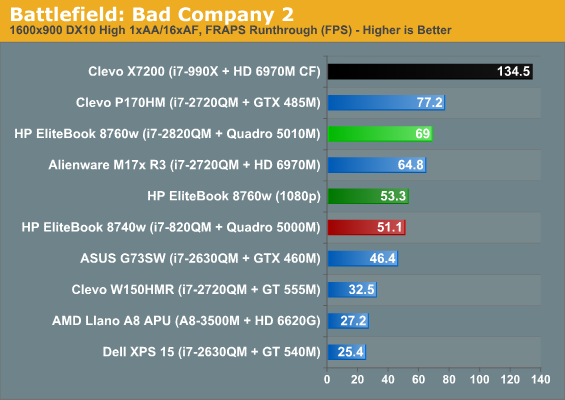
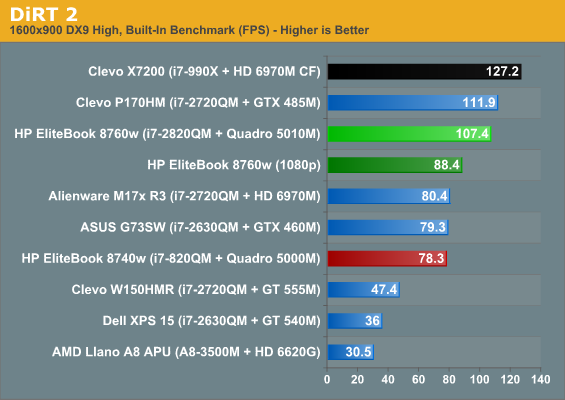
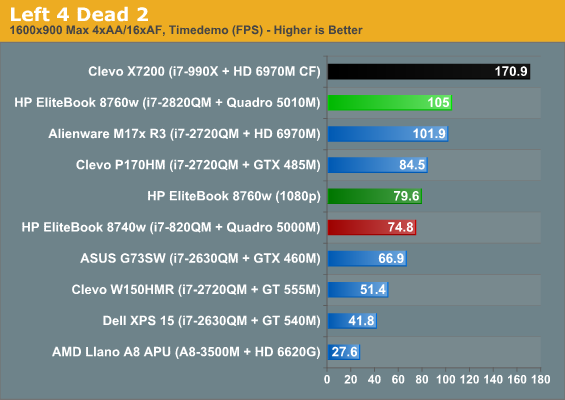
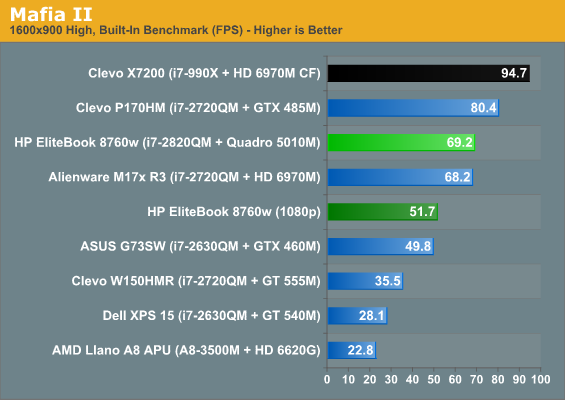
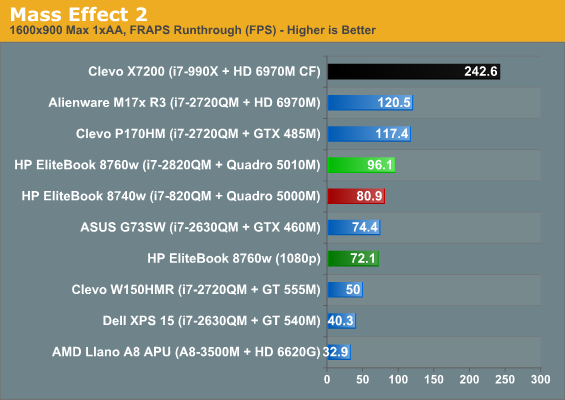

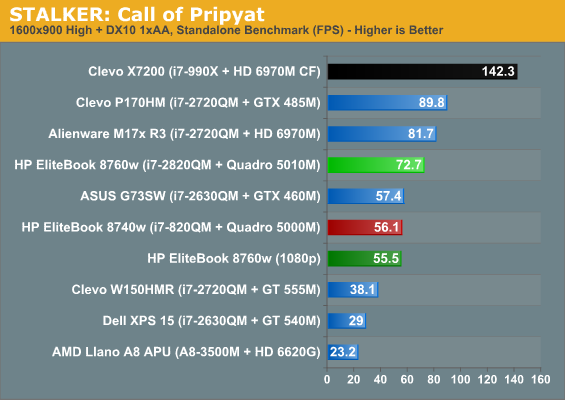
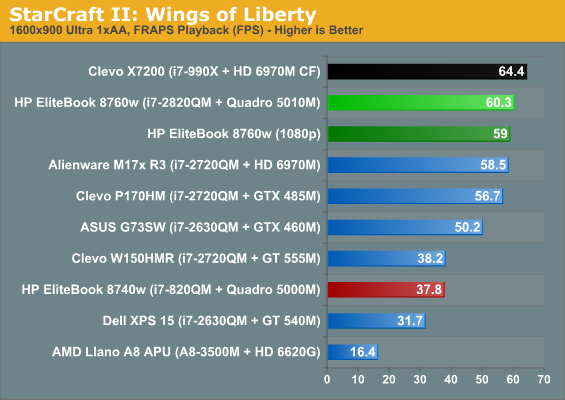
The Quadro 5010M certainly isn't slow, but in situations where it isn't CPU bound the GeForce GTX 485M and AMD Radeon HD 6970M both offer substantial performance improvements. In some cases the extra clocks and shader muscle over the previous gen 5000M earn you an extra step in resolution, but let's see what happens when we shift the bottleneck almost entirely to the GPU.
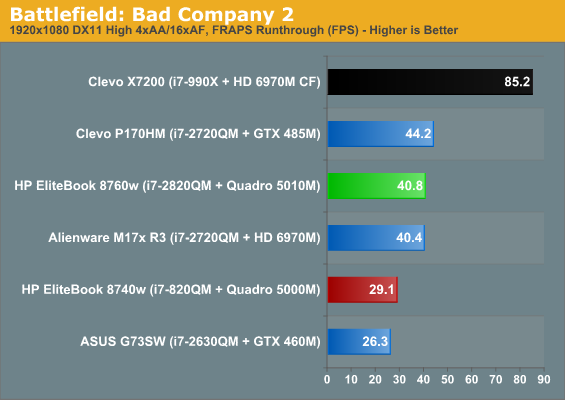
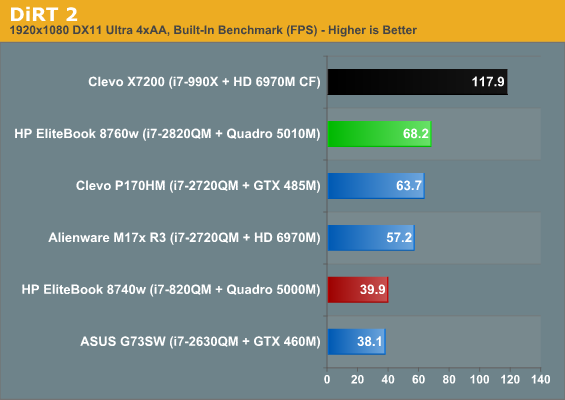
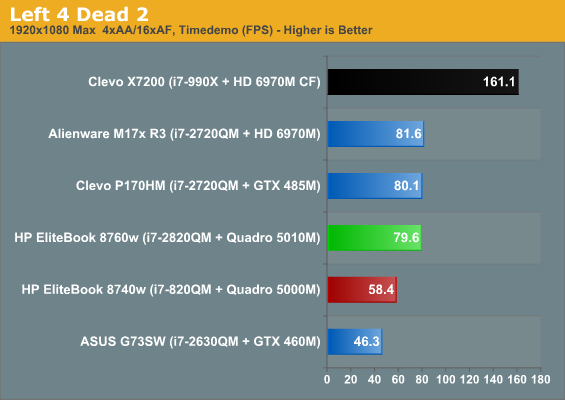

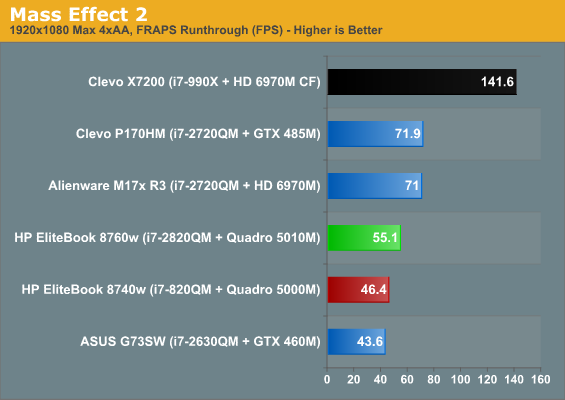
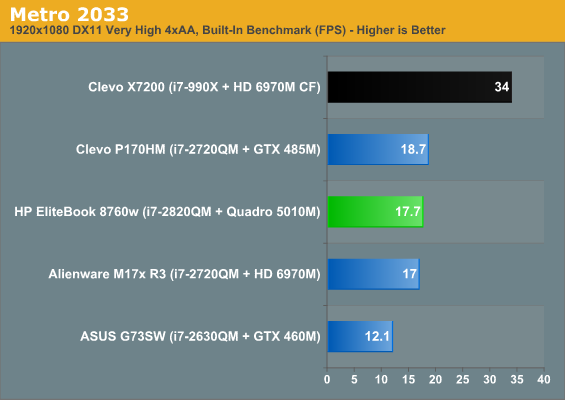
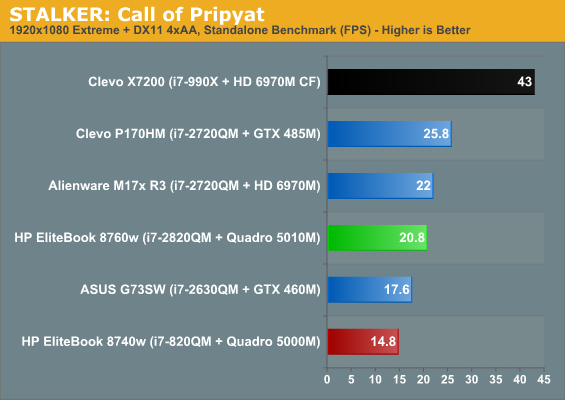
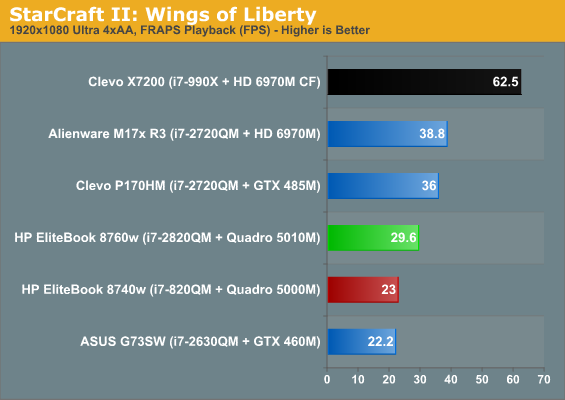
Things play out about how we'd expect. The Quadro 5010M can certainly hold its own in gaming, but it's not really a gaming GPU in the truest sense and that shows here, where the GTX 485M is able to provide better performance in the same power envelope. Let's also not forget cost here: Quadro GPUs are professional graphics cards and usually cost two or three times as much as their GeForce equivalents, so while it's possible to game on your paid-for-by-the-boss workstation, that's the only reason you'd want to game on Quadro.










83 Comments
View All Comments
Siorus - Thursday, August 25, 2011 - link
Nice writeup as always Dustin. I was just in the market for a 17" mobile workstation, and it came down to either the 8760w or the Dell Precision M6600. I very nearly went with the HP because I wanted the ips panel, but ultimately I wanted Optimus more.At least I know for sure now that the ~$1k price premium on the HP (before adding the IPS panel or the 5010) evidently stems from some delusion that the HP brand still carries a reputation for premium products (something which I suspect most people stopped believing at about the same time that calculators with reverse polish notation started losing popularity), rather than because the machine is engineered and built to a standard that justifies it.
Looking at those temperatures and the machine's internals makes me glad I went with the Dell. Mine has a 2920XM in it (55w TDP vs 45 for the 2820) and it still doesn't get anything like as hot as the HP does. Furmark and prime95 will get the GPU (a quadro 4000 in this case, which I believe has the same 100w power envelope as the 5010, if not the same real-world TDP) and the CPU into the low 70s and low 80s, respectively. CPU temps over 90*c in a 17" dtr are beyond ridiculous; they're downright asinine. Trying to cool a 100w GPU AND a 45w CPU in a notebook using only one fan is idiotic.
I mean, I'd love to have the 5010 and that ips panel in the m6600, but from a build quality standpoint the Dell looks to be a much nicer machine. And with Optimus and a nearly 100Whr battery I can see 7hrs+ of real-world usage on a charge. If you need the IPS panel (and those of you that do already know that you do), this is your only option until Dell releases theirs (hopefully later this year). For the rest of you that need a 17" mobile workstation... I'd strongly suggest taking a pass on this one and grabbing a m6600 instead.
Solidstate89 - Thursday, August 25, 2011 - link
As an owner of a Dell Precision M4600, I have to agree with everything you just said. I essentially use the same CPU (just clocked .1GHz lower) as this, and yet it runs at least 10 degrees cooler under load if not more. I can't believe it can even get remotely that hot in a much larger 17" chassis.Aaron_J - Saturday, August 27, 2011 - link
I also absolutely agree with your comment. I too looked at the Dell vs the HP and ultimately chose the m6600 and could not be happier with my choice. Nearly everything 8760w does, the m6600 does better and for less money. The m6600 bases at a much lower price point and offers nearly the same components.As of yet the m6600 is not available with an IPS screen or the Nvidia 5010m, however it still does not lag behind in performance because of this. The Quadro 4000m is still a beast and ultimately matches the 5010m when overclocked. I overclock my 4000m to 620/1240/1625 (core/shader/memory) from the stock 475/950/1250 clock and the temps still max out at just over 70*c while gaming. Im sure that the 5010m would also be a great a overclocker but certainly not in the 8760w, the cooling is simply far too inadequate to handle it.
There are many other smaller details that I believe push the m6600 ahead of the 8760w, and as such it'd be great if Anandtech did a comparison review of the two.
Sufo - Thursday, August 25, 2011 - link
16:9 is for TVs.I don't understand why there has been this push. Who does it benefit? The only things it's beneficial for is the elimination of black bars around video. Big deal. To be honest, I'd happily sacrifice a little pixel density to have an appropriate aspect ratio. There were very good reasons for the adoption of 16:10.
I was going to buy an x220 - didn't because of the 16:9 panel. It's now becoming apparent that I can't keep this up, as soon I will have no other options.
Oh, and that pixel density jump that everyone's waiting for? Not happening any time soon. Next gen of consoles will output at 1080p mark my words - and video won't be released in higher than 1080p for some time (not to mention the limits of HDMI etc). So until there is media that requires greater res, we are stuck here.
If anyone can offer me some words of comfort/hope, please feel free.
Ushio01 - Thursday, August 25, 2011 - link
When manufacturing LCD's from the standard set size of glass you can get more 16:9 than 16:10 panels of the equivalent size and also get less waste glass.As to your other comment the most common size monitors were 5:4 1280x1024, 16:10 1680x1050 and now 16:9 1920x1080 so yes monitor resolutions are increasing.
In the UK for what it cost to buy a 22" 1680x1050 TFT monitor 3 years ago you can now get a 23" 1920x1080 IPS monitor or if you want something bigger a 27" 2560x1440 monitor is now available for what it used to cost to buy a 1920x1200 monitor.
HMTK - Thursday, August 25, 2011 - link
You get more pixels on your screen but the ratio between vertical and horizontal if getting way out of proportion making the higher resolution less efficient. Maybe 16:9 is nice for movies and a wide spreadsheet but 16:10 and even 4:3 or 5:3 are far better when working on text documents or drawings. I still have a nc6320 or soemthing with a 15" 1400 x 1050 screen. It's getting a bit long in the tooth but I still like that screen better than the 1600 x 900 affair that's common on many laptops today.noeldillabough - Friday, August 26, 2011 - link
I too feel your pain but the performance increase s so worth it. Also, buy the X220 its the best netbook ever (yeah it's a laptop but compared to my workstations it's a netbook)I have an Air too and I love the X220 the best.
Medallish - Thursday, August 25, 2011 - link
I actually like the new HP business laptops looks, I ordered a Probook 6465b myself, sports the same kind of look as Elitebook, although at 14" and with Llano :P.I hope Lenovo sees this and starts improving their Thinkpads, and that finally we start seeing screens improving, another reason why I bought the probook was the 1600x900 that's almost impossible to find in a mid-priced laptop.
arnavvdesai - Thursday, August 25, 2011 - link
The Sony Vaio Z has a 13" screen & it has a 1080p resolution. Its time to get better screens.Sladeofdark - Thursday, August 25, 2011 - link
Thank you for the great review as always. Now im going to go find out what Clevo is.. and purchase one.